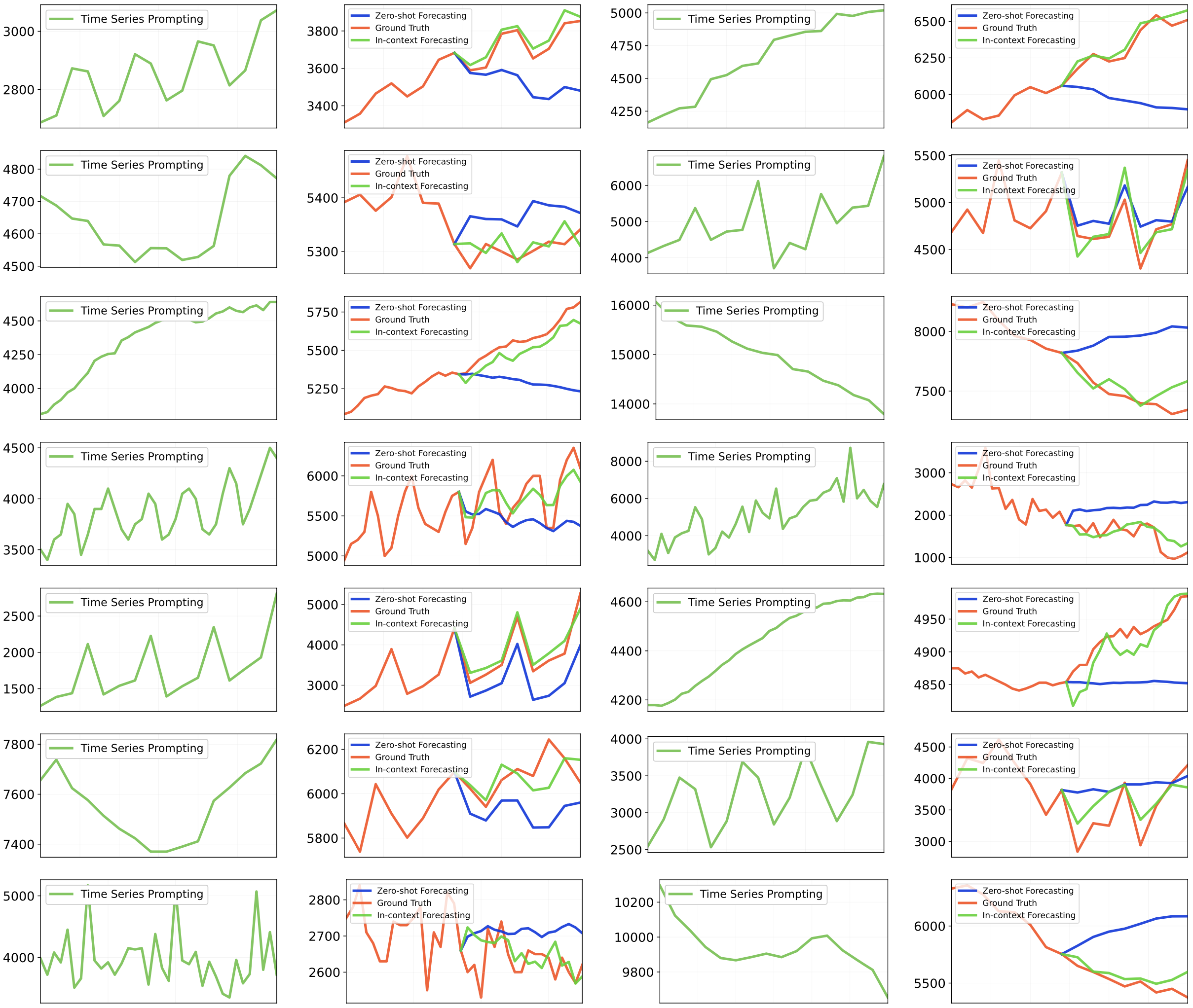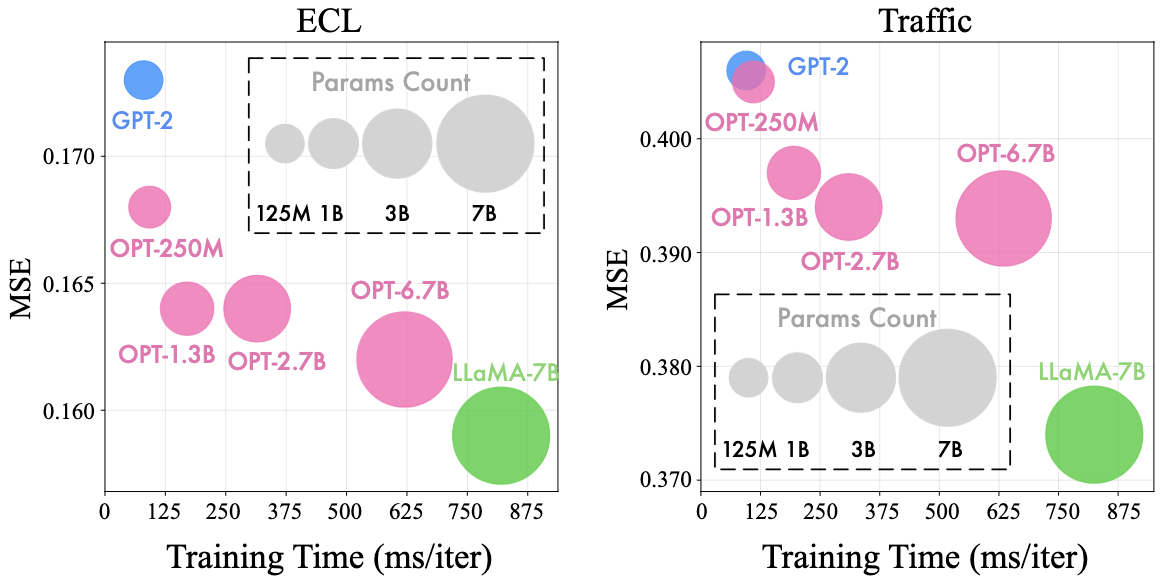The repo is the official implementation for the paper: AutoTimes: Autoregressive Time Series Forecasters via Large Language Models. It currently includes code implementations for the following tasks:
Time Series Forecasting: We repurpose large language models as out-of-box time series forecasters on benchmarks including long-term and short-term forecasting.
Zero-shot Forecasting: Large models exhibiting remarkable zero-shot capability are beneficial for data-scarce applications. AutoTimes takes advantage of this and demonstrates good performance without training samples.
In-context Forecasting: We propose in-context forecasting for the first time, where instructions in time series itself are available to further enhance forecasting.
Generality on Large Language Models: AutoTimes can be easily applied to various kinds of large language models, demonstrating generality and proper scaling behavior.
🚩 News (2024.2) All the scripts for the above tasks in our paper are available in this repo.
We provide several showcases of zero-shot and in-context forecasting results.
🌟 While prevalent forecasting models adopt the encoder-only structure with projection, we propose AutoTimes, a simple but effective way to convert generative LLMs as autoregressive forecasters with frozen parameters. Token-wise Prompting is also proposed to incorporate textual information (e.g. timestamps).
💪 We aim to fully revitalize the capabilities of LLMs as foundation models of time series, including autoregressive token generation, zero-shot capability, in-context learning, and multimodal utilization.
🏆 AutoTimes demonstrate competitive results with existing baselines and have shown proficiency in handling variable series lengths: one model for all forecast lengths and gain with prolonged lookback.
- Establish the tokenization by the consistent training of Next Token Prediction.
- Ultilize inherent token transitions within the frozen LLM blocks to predict time series tokens
- Prompted by textual covariates, such as timestamps aggregated in segments.
- Install Pytorch and necessary dependencies.
pip install -r requirements.txt
-
Put the datasets [Google Drive] [Tsinghua Cloud] under the folder
./dataset/. -
Download the large language models from Hugging Face and specify the model path using the
llm_ckp_dirparameter in scripts. -
Train and evaluate the model. We provide all the above tasks under the folder
./scripts/.
# the default large language model is LLaMA-7B
# long-term forecasting
bash ./scripts/time_series_forecasting/long_term/AutoTimes_ETTh1.sh
# short-term forecasting
bash ./scripts/time_series_forecasting/short_term/AutoTimes_M4.sh
# zero-shot forecasting
# it's worth noting that sM4_tM3 utilizes models trained
# on short-term, you should run AutoTimes_M4 first
bash ./scripts/zero_shot_forecasting/sM4_tM3.sh
bash ./scripts/zero_shot_forecasting/sM3_tM4.sh
# in-context forecasting
bash ./scripts/in_context_forecasting/M3.sh
# other large language models
bash ./scripts/method_generality/opt.sh
# preprocess timestamps to generate text embedding
python ./preprocess.py --gpu 0 --dataset ETTh1
We evaluate the performance under the zero-shot scenario, where the forecaster is first trained on a source domain and then directly evaluated on the unseen target domain.
AutoTimes can also utilize the instructions in time series, where we propose in-context forecasting. Inspired by In-Context Learning of LLMs, we provide forecasting demonstration from the target domain as the prompt. The composed time series sentence is fed into our forecaster, which effectively empowers the prediction.
AutoTimes demonstrates competitive performance in long-term and short-term scenarios. Notably, AutoTimes adopts only one single model to tackle arbitrary forecast lengths by autoregression, whereas other baselines necessitate training respectively on different lengths.
We evaluate the efficiency of each repurposed LLM from three perspectives: forecasting performance, training speed, and parameters, demonstrating improved performance with the increase of parameters that validates the scaling law.
We conduct the ablation on Token-wise Prompting by integrating timestamps. The performance is consistently promoted by the datetime information across all datasets and forecasting lengths.
As language models can generally give more accurate answers with a longer context, the performance of AutoTimes is generally improving with the more available lookback observations, which is highly desired in real-world applications.
Despite LLM having a substantial amount of parameters, AutoTimes requires only minimal parameters (up to 0.1%) for training, acomplished by a single pair of MLPs for time series tokenization as the plugin of LLMs.
Tutorials are provided in this repo.
If you find this repo helpful, please cite our paper.
@article{liu2024autotimes,
title={AutoTimes: Autoregressive Time Series Forecasters via Large Language Models},
author={Liu, Yong and Qin, Guo and Huang, Xiangdong and Wang, Jianmin and Long, Mingsheng},
journal={arXiv preprint arXiv:2402.02370},
year={2024}
}
We appreciate the following GitHub repos a lot for their valuable code and efforts.
- Time-Series-Library (https://github.com/thuml/Time-Series-Library)
- FPT (https://github.com/DAMO-DI-ML/NeurIPS2023-One-Fits-All)
If you have any questions or want to use the code, feel free to contact:
- Yong Liu (liuyong21@mails.tsinghua.edu.cn)
- Guo Qin (qing20@mails.tsinghua.edu.cn)








